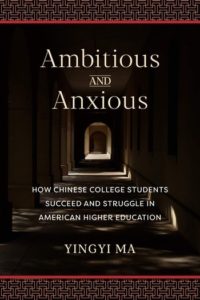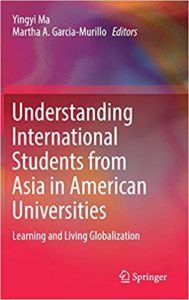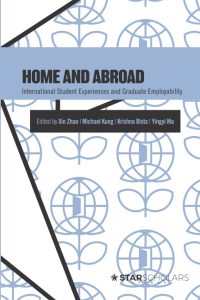Driven but Adrift:
Unraveling the Impact of American Higher Education, Immigration Policy, and the Changing China on Chinese Youth
Author: Yingyi Ma
Columbia University Press (Under Contract)
Ambitious and Anxious:
How Chinese College Students Succeed and Struggle in American Higher Education
Author: Yingyi Ma
Columbia University Press

Over the past decade, a wave of Chinese international undergraduate students—mostly self-funded—has swept across American higher education. From 2005 to 2015, undergraduate enrollment from China rose from under 10,000 to over 135,000. This privileged yet diverse group of young people from a changing China must navigate the complications and confusions of their formative years while bridging the two most powerful countries in the world. How do these students come to study in the United States? What does this experience mean to them? What does American higher education need to know and do in order to continue attracting these students and to provide sufficient support for them?
In Ambitious and Anxious, the sociologist Yingyi Ma offers a multifaceted analysis of this new wave of Chinese students based on research in both Chinese high schools and American higher-education institutions. Ma argues that their experiences embody the duality of ambition and anxiety that arises from transformative social changes in China. These students and their families have the ambition to navigate two very different educational systems and societies. Yet the intricacy and pressure of these systems generates a great deal of anxiety, from applying to colleges before arriving to looking ahead upon graduation. Throughout the book, Ma sheds light on the role of class in the experiences of this relatively privileged population. Ambitious and Anxious also considers policy implications for American colleges and universities, including recruitment, student experiences, faculty support, and career services.
Click here for book reviews.
Click here for book content.
Understanding International students from Asia in American University:
Learning and Living Globalization
Edited by: Yingyi Ma and Martha Garcia-Murillo
Springer Press

This book is about international students from Asia studying at American universities in the age of globalization. It explores significant questions, such as: Why do they want to study in America? How do they make their college choices? To what extent do they integrate with domestic students, and what are the barriers for intergroup friendship? How do faculty and administrators at American institutions respond to changing campus and classroom dynamics with a growing student body from Asia? Have we provided them with the skills they need to succeed professionally? As they are preparing to become the educational, managerial and entrepreneurial elites of the world, do Asian international students plan to stay in the U.S. or return to their home country?
Asian students constitute over 70 percent of all international students. Almost every major American university now faces unprecedented enrollment growth from Asian students. However, American universities rarely consider if they truly understand the experiences and needs of these students. This book argues that American universities need to learn about their Asian international students to be able to learn from them. It challenges the traditional framework that emphasizes adjustment and adaptation on the part of international students. It argues for the urgency to shift from this framework to the one calling for proactive institutional efforts to bring about successful experiences of international students.

This book explores the socio-political environment that impacts international students’ employability and discuss student experiences of employability development during and after their studies. The book also aims to provide a holistic understanding of international student employability on a global scale, incorporating various higher education contexts, including the US, UK, Netherlands, Vietnam, and Japan. This book includes both conceptualizations of international students who participate in “internationalization abroad” through physically crossing the border and those who participate in “internationalization at home”. The COVID-19 pandemic has potentially transformed international education as many international students were forced to stay in their home countries and resort to online education. The book looks into the bigger questions: How do the institutions of higher education expand programs and resources for international students and their employability? Is the internationalization at home model going to be increasingly popular in the post-pandemic world? Will employers be receptive to international graduates globally?
